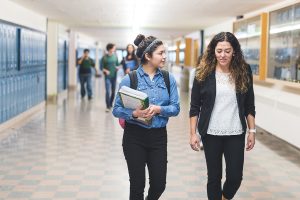Third in a special Baltimore’s Child series about school safety
This past spring, Gov. Larry Hogan approved the Maryland Safe to Learn Act of 2018. Effective June 1, the act requires public schools to have “either a school resource officer or plans for adequate law enforcement coverage” in place by the start of the next school year and for public middle and elementary schools to have the same by the following school year.
 The new law does not just address students’ safety in the event of a shooter or other crisis, however. It offers preventative measures, too, in the form of mental health services. Under the law, each school system is required to appoint a mental health coordinator to ensure that students are receiving adequate mental health services both in and out of school — particularly those that demonstrate “specified behaviors of concern.”
The new law does not just address students’ safety in the event of a shooter or other crisis, however. It offers preventative measures, too, in the form of mental health services. Under the law, each school system is required to appoint a mental health coordinator to ensure that students are receiving adequate mental health services both in and out of school — particularly those that demonstrate “specified behaviors of concern.”
While some have celebrated the law’s mental health component, others, like Sharon A. Hoover, co-director at the University of Maryland Center for School Mental Health, do not feel that mental health should be associated with school violence.
“My hope is that, in general, people understand that incidents of violence are not committed by people with mental illness,” Hoover says. “I’m concerned people with mental illnesses will be stigmatized by the incidents of violence.”
With the increased media attention equating mental health to school violence,
Hoover fears that students affected by mental health issues may have increased anxiety and be less likely to get help for fear of being stigmatized.
The law fails to address, too, what she sees as another major issue with mental health in schools. Most schools use a referral system to identify students in need of mental health treatment, she says, but this system relies on referrals from parents, teachers, counselors and students themselves. As a result, “many students slip through the cracks.”
Her solution? Systematic screening. With this method, school health employees use surveys and other screening tools to identify at-risk students. Hoover’s hope is for mental health screening to be required in schools as commonly as is vision and hearing screening.
This plan would eliminate what Rich Salkin, behavioral interventionist at Franklin High School, finds to be one of the biggest issues surrounding mental health in schools.
As a school counselor, he can only make “strong recommendations” to parents — the rest is up to them.
“It’s been the commitment of public schools to identify students with mental health issues for quite some time,” Salkin says. “The conversation more centers on the limitations that we have in what can be done. The parents must step up and follow through with those recommendations.”
Though the new legislation may grant more authority to administrators and faculty for “wraparound services,” Salkin and his colleagues did not need the law to know that they had to take a more active role in their students’ well-being.
“I’m all over the place in this school,” he says. “The main thing is not to wait for students to come to me, but to observe who has the serious or distraught look or who is struggling in the classroom and ask them what is wrong.”
“Certainly, in the wake of school shootings or other local events, we are put on high alert for developing conflicts and incidents at school,” he adds. “That is not really policy driven, but rather a matter of ethics and devotion to the safety and care of our students.”
Salkin urges school staff to be “approachable” in order to ensure that students will be more open to discussing their problems and concerns.
“Showing genuine interest in their lives, their moods and their personalities makes the communication two-way, and thus, a student will feel comfortable asking for help.”
He advises parents to communicate with their children and to take everything they say seriously where mental health is concerned. To see lasting improvement in schools, however, Salkin believes that major changes still need to be made.
“Lower class sizes, funding for programs, improved teacher training, technological improvements and other components lead to the improved identification of mental health issues and safer schools,” he says.
Some might argue, too, that more counselors are needed, though national standards are in place. Judy Klinger, supervisor of school counseling for the Carroll County Public School System, says that there are approximately 85 school counselors throughout the school system. Elementary schools have one counselor, middle schools have two, and high schools have a minimum of four.
“We subscribe to the national model, The American School Counselor Association, which has a framework that outlines the domains of school counseling — academic, career and social/emotional,” Klinger says. “We have specific standards that we work at to be sure to cover.”
Cindy Hess, a school counselor at Taneytown Elementary School, provides lessons and small group workshops for students to work on different skills, such as emotional management, grief management and relationship-building.
“We went to a schedule this year, called flex time, where a group could spend half hour working with administrators on skills or attend counseling.” Hess says. “The mental health needs of children and young people seem to be getting more intense and starting at a younger age.”
At the Association of Independent Maryland and D.C. Schools (AIMS), however, executive director Peter Baily says that a focus on holistic well-being — including mental health — is nothing new. At AIMS schools, regular meetings are conducted for both small groups of students and individuals, with wide-ranging topics such as physical safety, mental health, social relationships, romantic and sexual relationships, cultural competency and responsible decision-making.
Baily says, too, that while they certainly don’t discount the prevalence of shootings, they have been equally forthright about the statistics that show that being on a school campus is still among the safest places for children and adults.
Whether mental health has a direct connection to school violence or not, it’s hard to argue that an increased (or, in some cases, sustained) focus on the holistic well-being of children is a positive thing.
As Hess says, “the main goal [is] trying to meet the needs of the students.” BC
Writers Oyin Adedoyin, Willow Pinkerton, Alex Rychwalski, Meg Tippett
and Kimberly Uslin contributed to this story.








